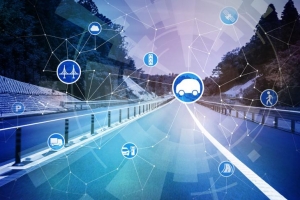
Whether you’re aware of it or not, your trucking company has already been affected by digitized trucking. ELDs. Blockchain. Integrated supply chains.
These are just some of the elements of digitized trucking that are already in use today. And while experts like PwC’s Strategy& team predict that fully digitized trucking is still at least a decade away, transportation companies must begin implementing the right technology today, so that they’re ready for what’s coming down the pipeline.
What exactly is digitized trucking?
The digitized truck is an automated, connected vehicle that can communicate with other vehicles as well as command centers like warehouses and company headquarters.
The fully digitized truck would be self-driving and able to automatically transmit its location to other vehicles in its fleet, the warehouse, or end customer waiting on its arrival — and the fleet manager who sent it out.
It would transform the domestic supply chain, as the trucks’ arrival and departure times, the products they carry, and the routes they take will be able to be checked, verified, and re-checked by multiple stakeholders in real time.
Because of this, digitized trucks could remove much of the uncertainty that entities within the supply chain currently deal with. They’re especially relevant for players in the last mile, where accuracy and transparency are of paramount importance — not only for customer satisfaction, but to avoid further negative impacts on urban infrastructure.
Digitized trucking: Impossible without the IioT
The IIoT, or Industrial Internet of Things, is what’s making digitized trucking possible. Like the Internet of Things, or IoT, the IIoT allows different connected objects in an industrial setting to communicate with each other.
Machines can update each other on what step in a process they’re on and cars can communicate with each other to avoid collisions. Trucks can send updates to freight carriers and shippers, notifying them of when they have extra room for more products. The IIoT can also provide value with predictive maintenance.
If more and more trucks can be connected to a main internet grid that allows them to communicate with each other and other companies in the supply chain (regardless of the fleet each truck belongs to), shippers, freight carriers, and end customers could reap massive benefits.
This kind of connectivity would allow for a huge reduction in inefficiencies, reducing costs and the time it takes to get a product from one point to another.
What will this mean for truck drivers?
While self-driving trucks (though still years from becoming mainstream) will lower the number of truck driver positions, it’s likely that these positions will not disappear. Rather, they’ll change and evolve.
With these connected systems will come a need for people to interpret the data they’re sending, manage that data, and use it to develop better truck schedules and routes.
Even self-driving trucks won’t be fully autonomous when they enter our nation’s roadways en masse. These trucks will need human drivers who can step in in emergencies or serve in a pilot role in the event of a malfunction or miscalculation on the part of the truck’s computer system. These drivers will, in all likelihood, be able to perform other parts of their job while they’re along for the ride.
Digitized trucking will revolutionize the way that freight is transported across the country, and the world. Is your company ready?